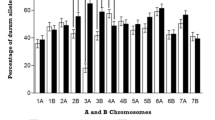Summary
A large number of diploid x hexaploid and diploid x octoploid crosses have been made by numerous workers with poor results. Crosses between synthetic tetraploids and species of higher levels of ploidy were successful. The success of these crosses and the high incidence of pentaploid progeny obtained by other workers from successful diploid x hexaploid crosses indicates that chromosomal or genetic imbalance in the endosperm or between zygote and endosperm is most likely the cause of failure to produce viable plants from 2x x 6x and 2x x 8x crosses.
Similar content being viewed by others
References
Allard, R. W., 1960. Principles of plant breeding. John Wiley, New York and London.
Dogadkina, N. A., 1941. A contribution to the question of genome relations in some species of Fragaria. C.r. Acad. Sci. URSS. 30: 166–168.
Evans, W. D. & J. K. Jones, 1967. Incompatibility in Fragaria. Can. J. Genet. Cytol. 9: 831–836.
Fedorova, N. J., 1934. Polyploid intespecific hybrids in the genus Fragaria. Genetica 16: 524–541.
Ichijima, K., 1930. Studies on the genetics of Fragaria. Z. indukt. Abstamm.- u. VererbLehre. 55: 300–347.
Lilienfeld, F. A., 1933. Karyologische und genetische Studien an Fragaria. I. Ein tetraploider fertiler Bastard zwischen F. nipponica (n=7) und F. elatior (n=21). Jap. J. Bot. 6: 425–458.
Lilienfeld, F. A., 1936. Karyologische und genetische Studien an Fragaria. II. Ist Fragaria elatior eine autopolyploide Pflanze? Jap. J. Bot. 8: 119–149.
Mangelsdorf, A. J. & E. M. East, 1927. Studies on the genetics of Fragaria. Genetics 12: 307–339.
Millardet, M. A., 1894. Note sur l'hybridization sans croisement ou fausse hybridation. Mém. Soc. Sci. phys. nat. Bordeaux 4: 347–372.
Müntzing, A., 1930. Über Chromosomenvermehrung in Galeopsis-Kreuzungen unde ihre phytogenetische Bedeutung. Hereditas 14: 153–172.
Schiemann, E., 1937. Artkreuzungen bei Fragaria. II. Z. indukt. Abstamm.- u. VererbLehre. 73: 375–390.
Schiemann, E., 1943. Artkreuzungen bei Fragaria. III. Flora, Jena 37: 166–192.
Schiemann, E., 1951. Offene Fragen in der Gattung Fragaria. Z. PflZücht. 30: 464–472.
Stephens, S. G., 1942. Colchicine-produced polyploids in Gossypium. J. Genet. 44: 272–295.
Thompson, W. P., 1930. Causes of differences in success of reciprocal interspecific crosses. Am. Nat. 64: 407–421.
Yarnell, S. H., 1931. Genetic and cytological studies on Fragaria. Genetics 16: 422–454.
Author information
Authors and Affiliations
Rights and permissions
About this article
Cite this article
Evans, W.D. Evidence of a crossability barrier in diploid x hexaploid and diploid x octoploid crosses in the genus Fragaria . Euphytica 23, 95–100 (1974). https://doi.org/10.1007/BF00032746
Received:
Issue Date:
DOI: https://doi.org/10.1007/BF00032746




